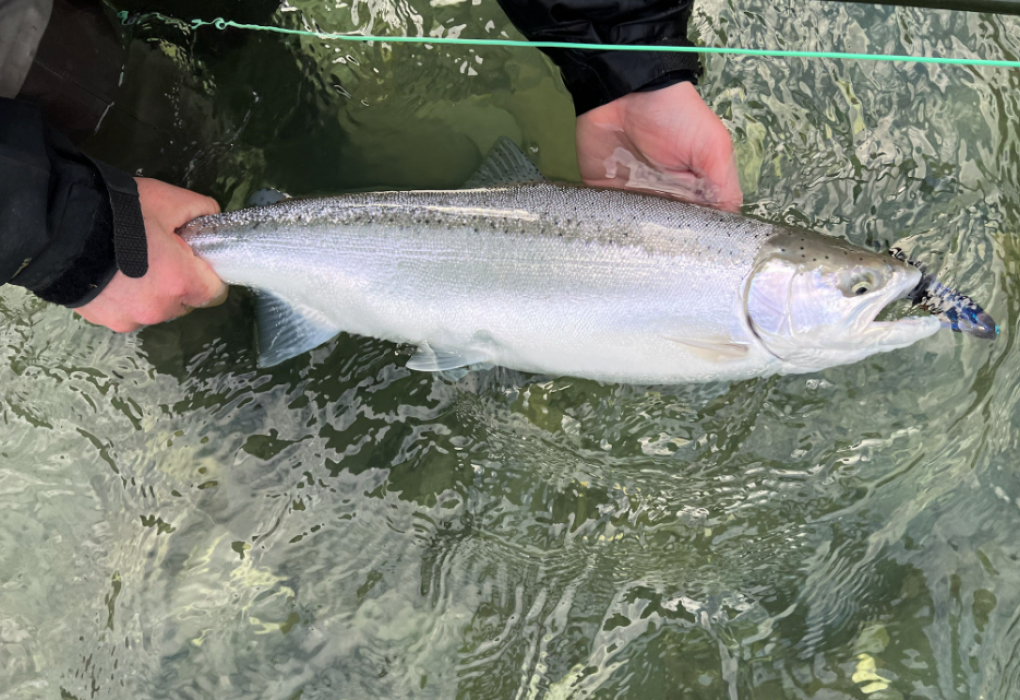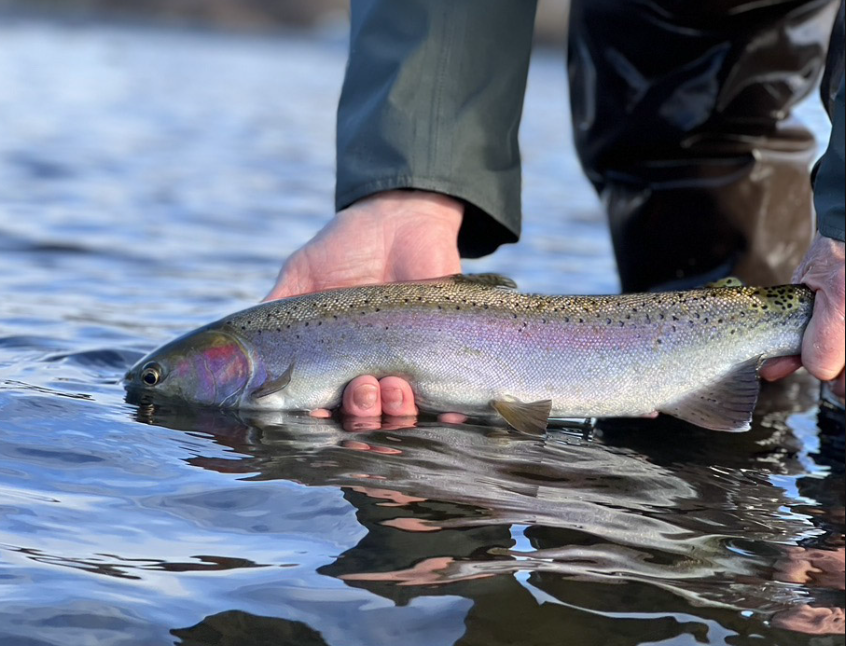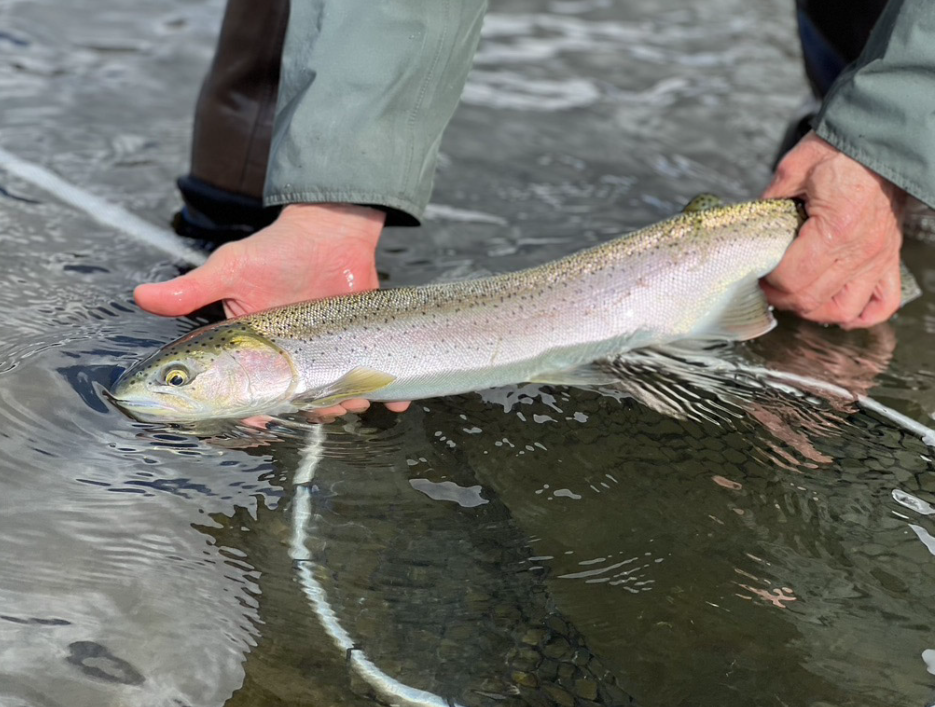Wild Winter Steelhead Go Catch-and-Release on the Rogue River for the First Time in History
This article is an update to our “Protecting Wild Steelhead in Southern Oregon” campaign, which focuses on improving the monitoring and conservation of wild steelhead returning to southern Oregon’s wild rivers. To learn more about the history of the campaign and this remarkable region for wild steelhead, check out the campaign webpage.
~ ~ ~ ~ ~ ~ ~ ~ ~ ~ ~ ~ ~ ~ ~
During the upcoming 2024–25 winter steelhead season (Dec. 1, 2024 – Apr. 30, 2025), the upper and middle sections of the Rogue River and the Illinois River will shift from harvest to catch-and-release regulations for wild winter steelhead for the first time since 2009 for the Illinois, and for the first time ever in Rogue River history. The lower Rogue River, defined as the mouth of the Rogue to the confluence with the Illinois River, will shift to an angling bag limit of 1 wild steelhead per person for the season. This conservation regulation change is a direct result of the advocacy of wild fish activists and River Stewards in Southern Oregon who called for better wild steelhead conservation and monitoring.
Why is this happening now?
For the 2024-25 season, wild winter steelhead in the Rogue River are at “Conservation Status.” “Conservation Status” is defined by the Oregon Department of Fish and Wildlife as, “a value below which long-term persistence becomes uncertain and life history diversity may be at risk.” ODFW bases the status of the Rogue River’s wild winter steelhead on annual monitoring of wild half-pounder steelhead. During the past two consecutive years 2022 and 2023, wild half-pounder steelhead returned at very low levels, triggering the change of status for wild winter steelhead adults.
How do half-pounder and adult steelhead relate?
Most adult Rogue River steelhead exhibit a half-pounder life history, where steelhead smolts return to overwinter in freshwater within their first year of entering the ocean. Essentially, half-pounders are the boomerang children of the steelhead world. Since they spend less than a year in the ocean, half-pounders are much smaller than adult steelhead. Most half-pounders are in the 12-16” range and weigh a half-pound or slightly more. When spring arrives, these half-pounders return to the ocean where they spend 1-2 more years growing to typical adult steelhead sizes.
Through the creation of the Rogue-South Coast Conservation and Management Plan, the relationship between half-pounder returns and subsequent adult winter steelhead returns was established as the best indicator for the abundance of the adult population, since no current adult winter steelhead abundance information could be provided by the state. As a result of low wild half-pounder returns over the past few years, state biologists believe the 2024-25 wild winter steelhead run will be much lower than average in the Rogue River, which according to actions specified in the management plan, prompts catch-and-release regulations for wild fish.
So, is catch-and-release good or bad news?
Overall this is good news - fewer wild steelhead will be killed in Southern Oregon’s fisheries. Thanks to your advocacy ODFW has a Commission-adopted fisheries plan that guides the management of Southwestern Oregon’s wild steelhead fisheries and it relies on more data and monitoring than in the past. It’s also good news that when a decline is likely to occur, ODFW is responding with actions to reduce the risk to wild fish. Of course, the bad news is that this year’s run of wild winter steelhead is likely going to be smaller than normal.
Why were wild half-pounders doing so poorly in 2022 and 2023? And what can we do to help them?
ODFW biologists in the Rogue Basin believe that the high severity of drought conditions in 2021 and 2022 are most likely the reason for the dramatic downturn in wild half-pounder steelhead seen in 2022 and 2023. Drought conditions both increase water temperatures and reduce the access of steelhead to tributaries. Biologists with the state recommend that advocates encourage the continued expansion of barrier removal in the Rogue River’s many tributaries to make as much habitat available to wild steelhead as possible.
What can you do to help wild winter steelhead on the Rogue River?
Send a message to the following Oregon Department of Fish and Wildlife staff and Commissioners:
Oregon Department of Fish and Wildlife Commissioners: ODFW.Commission@odfw.oregon.gov
Director Colbert: debbie.l.colbert@odfw.oregon.gov
Deputy Director Clements: Shaun.Clements@odfw.oregon.gov
South Coast District Biologist Mazur: Steve.J.Mazur@odfw.oregon.gov
Rogue District Biologist Van Dyke: Daniel.J.Vandyke@odfw.oregon.gov.
Thank them for implementing catch-and-release angling regulations throughout the majority of the Rogue River to reduce the risk to wild winter steelhead.
Encourage the staff and commissioners to:
Increase their communications and enforcement efforts around the new regulations.
Implement catch-and-release for wild winter steelhead in the lower Rogue River.
Advance critical research to better understand these fish including the Half-pounder Genetic Study and winter spawning ground surveys for winter steelhead in the Rogue.
Not to cut $68,000 in services and supplies associated with monitoring for winter steelhead in the Rogue River in ODFW’s 2025-27 budget.
If you fish the Rogue this winter, be sure you have the proper Rogue-South Coast Steelhead Validation, and make sure to use the best catch-and-release practices when fishing for wild winter steelhead:
Keep wild fish in the water.
Use a fish-friendly net.
Crush your barbs, so removing the hook does not damage the fish.
Retain all hatchery fish you catch.




